
Hollingworth Lake
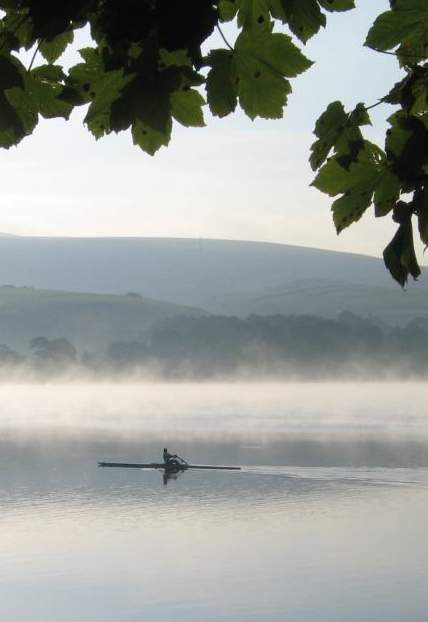 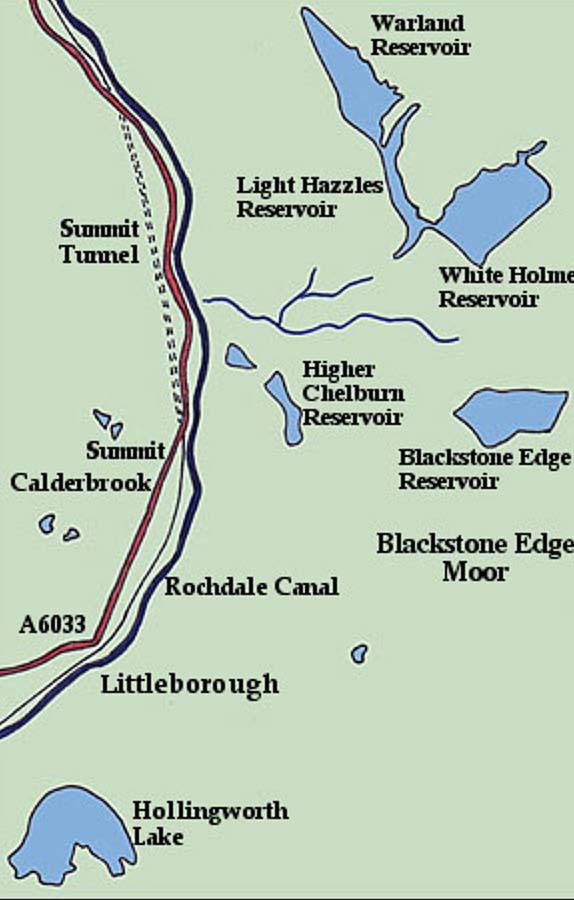 The Rochdale Canal opened over its whole length from Manchester to Sowerby Bridge in 1804. This made it the first Trans-Pennine canal, beating the Huddersfield Canal by 7 years and the Leeds and Liverpool canal by 12 years. The original concept for the Trans-Pennine portion of the Rochdale Canal had proposed a 1.6 mile tunnel between Walsden and Sladen. In the end the tunnel was dropped as a navigation option and replaced by a large number of locks which took the canal over a summit level of 600 feet. Whilst the canal took advantage of the routes created by natural waterways, it did not interfere or draw water from the natural rivers and streams. Water for the canal was provided by a series of reservoirs. Operating the 92 locks over the summit required a constant and copious water supply. A number of reservoirs were constructed on the Blackstone Edge, including the 90 acre White Holme Reservoir northeast of the village of Summit. Without question the most famous of the reservoirs, built to supply water to the canal, was Hollingworth Lodge which lies a short distance from Rochdale at Smithy Bridge. The term Lodge referred to the fact that this was a storage place for water. The water body soon became known as Hollingworth Lake. Unlike the reservoirs constructed in the deeply incised valley of the Pennines, Hollingworth Lake posed some construction problems since there was no natural depression. The normal method of reservoir construction, involving one dam across the mouth of a valley, would not work here. In fact, three earthen walls or embankments were constructed. The Hollingworth Bank cut off the Ealees Valley which runs to Littleborough. The Fens Bank runs across the northern shore. The third embankment was the Shaw Moss Bank which marked the southern boundary of the lake. In all the lake created covered 120 acres, including about 40 acres of low-lying marshland in the vicinity of Rakewood. 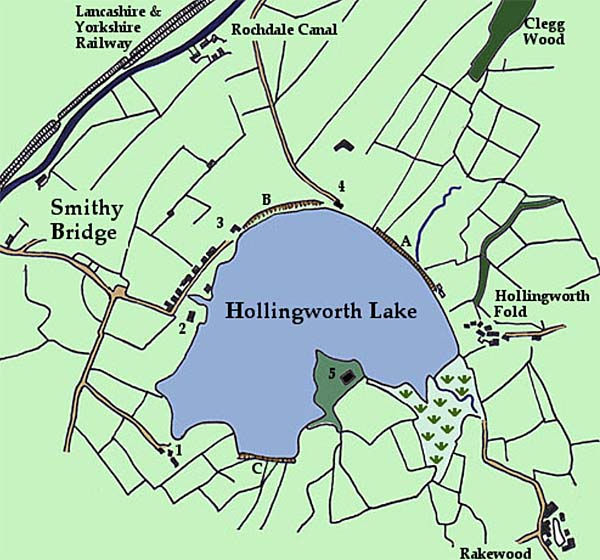 A - The Hollingworth Bank 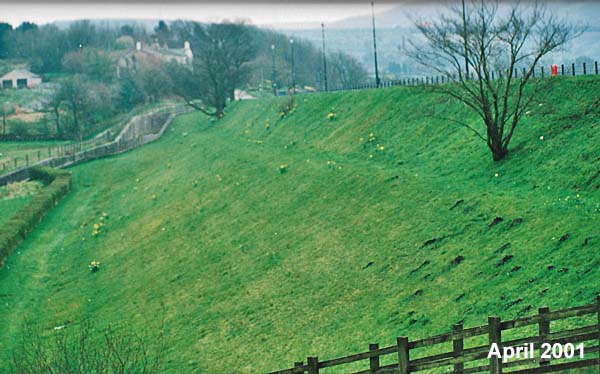 B - The Fens Bank 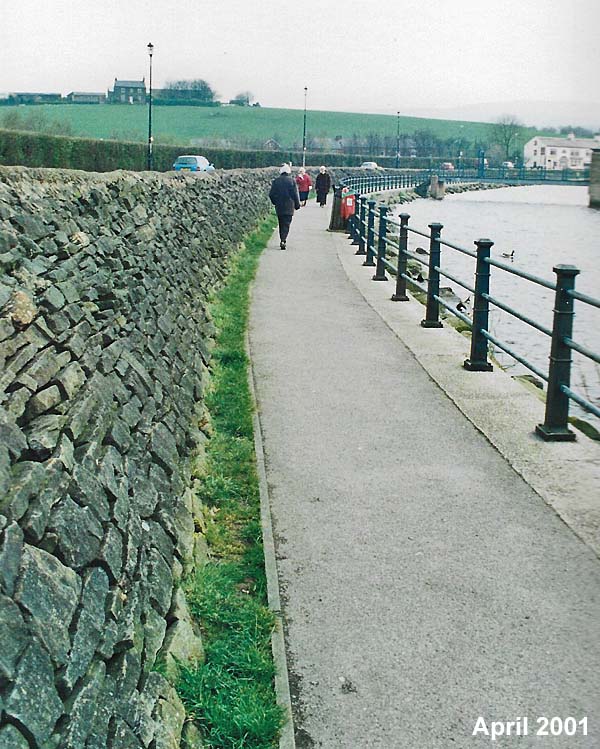 C - The Shaw Moss Bank the site of the
former Queen's Hotel
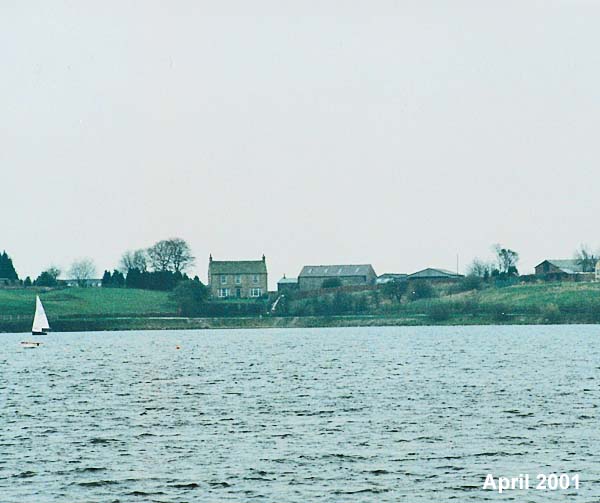 2 - The Beach Hotel 2001
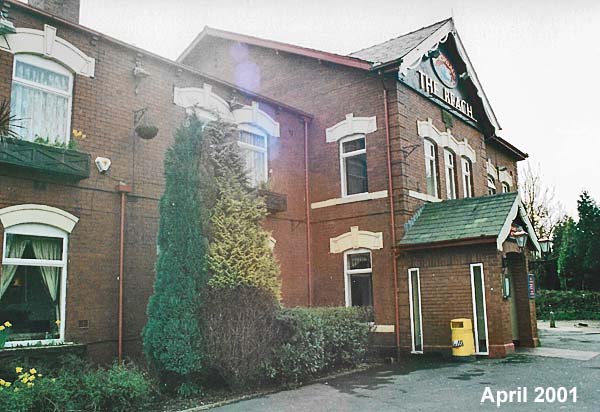 4. The Former Fisherman's Hotel, now The Wine Press 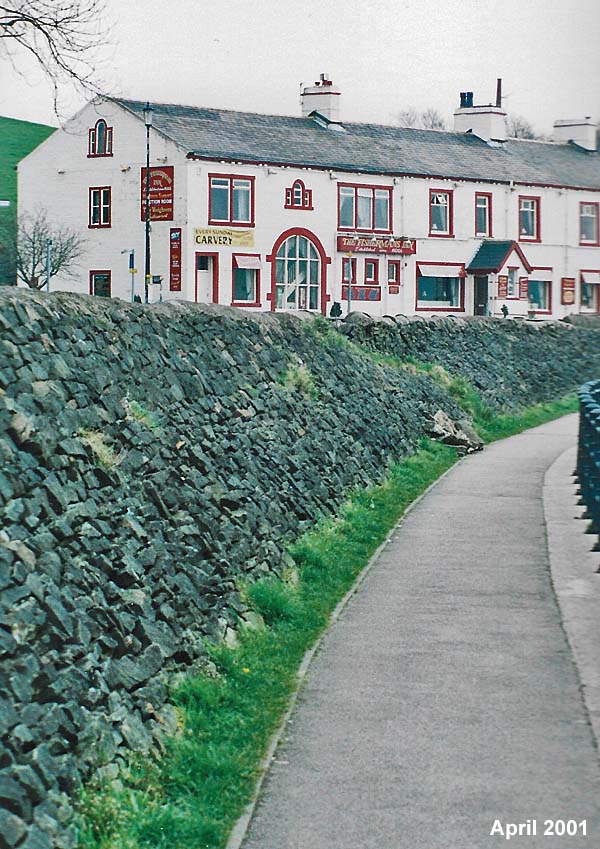 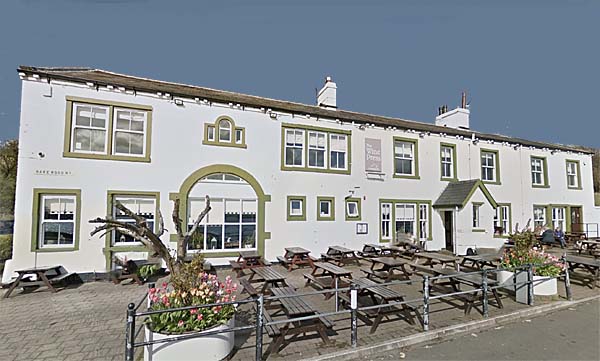 % - The site of the former Lake Hotel
on the opposite shore
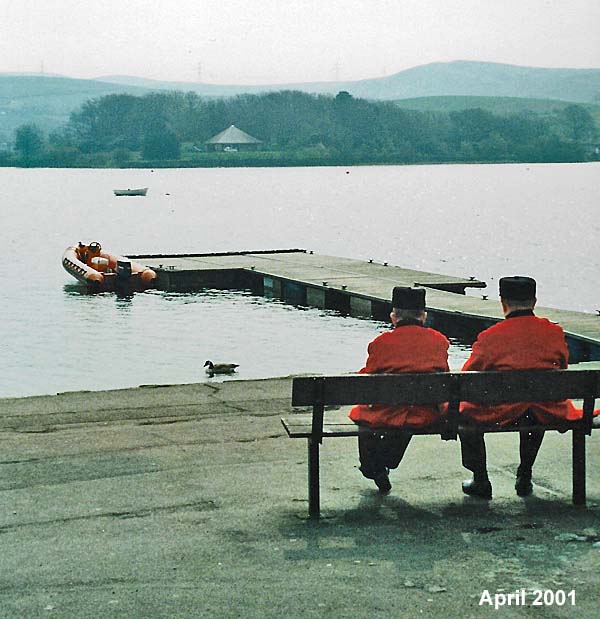 At one point water from the lake was raised by steam power and fed into a channel which ran 4 miles from the lake past Syke, Whittaker, Owlet Hall and on to Summit. Here it was used to replace water lost in the operation of the locks. The pumping engine and the building which housed it were demolished in 1910. There is also a drain which takes water down the Ealees Valley. 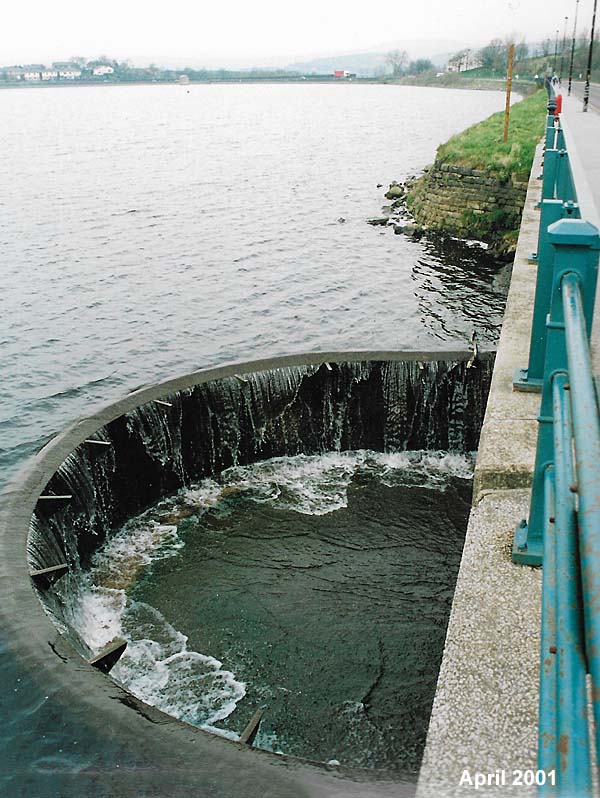  "The Weighver's Seaport - The Story of Hollingworth Lake" by A W Colligan JP says that, ".... The Lake, which is 2 miles and 372 yards around ..... has an average depth of 30 feet with a suggested depth of 80 feet at the centre .....". Other sources put the average depth at 3m (9.8 feet) and the maximum depth at 7.4m (24 feet). Over the years it has been stocked with fish, mostly bream, dace, and perch, but some trout were added in more recent times. In addition to its function as a lodge for the canal, Hollingworth also supplied water to the mills, which were springing up along the canal and the Littleborough -Todmorden road. However, the fame of the lake lies in the fact that, in the middle of the 19th century as the population grew rapidly in the area around Rochdale, Hollingworth Lake became a recreational resort offering a grand day out for visitors from near and far. The development of the lake and the land around it began when Henry Newell, the owner of Harehill Woollen Mills, and Mr. Staden, his engineer, acquired a lease for the use of the lake from the Rochdale Canal Company. Boating was one of the first developments and the first Rowing Club was founded in 1860. To provide accommodation and refreshment to the many visitors, hotels began to appear along the shore. The first were the Beach Hotel and the Lake Hotel . The Beach Hotel still remains beside the lake. In 1872 it bragged that it offered, "the comforts and attractions of a First-class Establishment". These included, "Private as well as Public Refreshment Rooms" and if notice were given, "any number of Persons up to One Thousand" could "be accommodated with a Place of Meeting Entirely to Themselves." Stabling was available for horses and vehicles and there was a "large and commodious Dancing Stage, which is brilliantly illuminated with gas at dusk." Henry Newell owned the new gasworks The Lake Hotel, sat on a promontory which projected into the lake on the south shore, was accessible on the ground along the eastern shore, but you could also cross the lake aboard the steamer for 2d. The steamers offered a ferry service to the Lake Hotel and its Pleasure Grounds, as well as trips around the lake. There was even an underwater telegraph cable between the booking office and the hotel to summon the ferry. The Pleasure Gardens around the Lake Hotel were laid out by Mr. Henderson from Birkenhead. Among the pleasures to be indulged in at the Lake Hotel, in the late 1800s, were billiards, bowls, quoiting, and roller-skating using "Plumpton's Patent Roller Skates" hired at the rate of 6d. Even before the lake was built there were hotels in the
vicinity. There was The Fisherman's Inn located
on what became the approach to the lake from
Littleborough. The Fisherman's Inn became The Wine
Press. 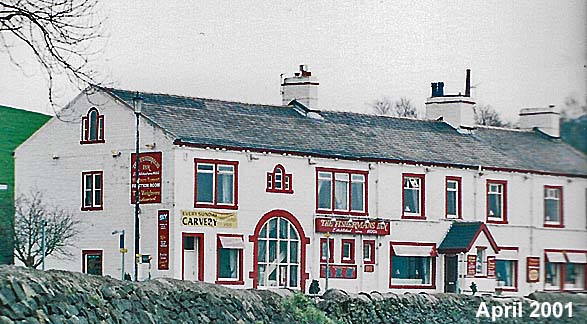  The Mermaid Hotel was built on the east side of the lake near Hollingworth Fold. At one time the hotel tenant was James Sladen of the Beach Hotel. The Mermaid closed for the last time in 1911. The Queens Hotel, later known as Marlands Queens Hotel, was created by remodeling a 17th century farm house at Peanock, close to the Shaw Moss Bank. The Queen described itself as a "Fashionable Place of Resort" and offered its patrons "A spacious pavilion" and a "Dancing Stage in the Grounds". It also catered for groups of up to 200 people. Today the hotel is once more a farm. The Lodge Inn opened for business in 1826. It was located south-east of the lake at the village of Rakewood. The Inn was described as, "most delightfully situated, commanding from its windows an extensive view of the lake." It also offered visitors, "Excellent Accommodation and Moderate Charges." It also had "Private Rooms for PIC-NIC Parties." The Lodge closed in 1917 and the hotel itself was converted into houses. At the west end of the Fens Bank on the lake's north shore the Lancashire and Yorkshire Hotel was built in 1876. It sat close to the steamer landing station and "Ten minutes walk from Smithy Bridge Station." It was promoted as a "far-famed and picturesque resort...replete with every accommodation for (the visitor's) pleasure and comfort." It also offered an 18,360 square foot dancing platform with a band in attendance daily. When the hotel was demolished, the stone was used to build a group of houses that now occupy the land. As the popularity of the lake declined and tastes changed, one hotel after another closed and in many cases the buildings were re-deployed. 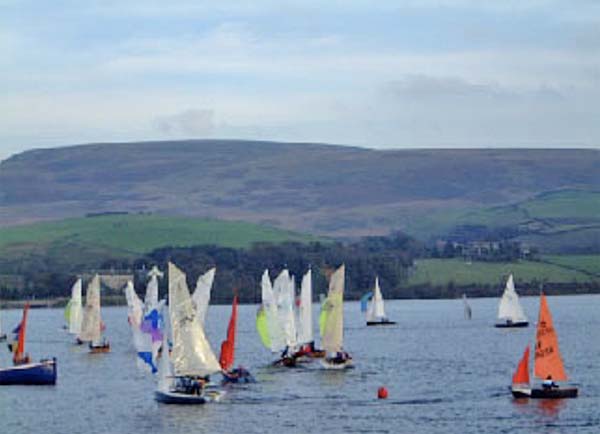  Hollingworth Lake today is the centre-piece of a
Country Park which attracts boaters, fishermen, and
walkers who want to enjoy the lake, its wildlife and the
surrounding scenery. In its day the lake-sides heaved
with thousands of people, the water buzzed with steamers
and rowboats and along the shores people danced,
picnicked, sought refreshment and entertainment at the
hotels and enjoyed the amusements. There were regattas
and swimming contests, fortune tellers, conjurers and
tricksters. People parted with their hard-earned brass
at the shops selling gifts, sweets, snacks and
souvenirs. It was indeed like a day out at the sea-side. 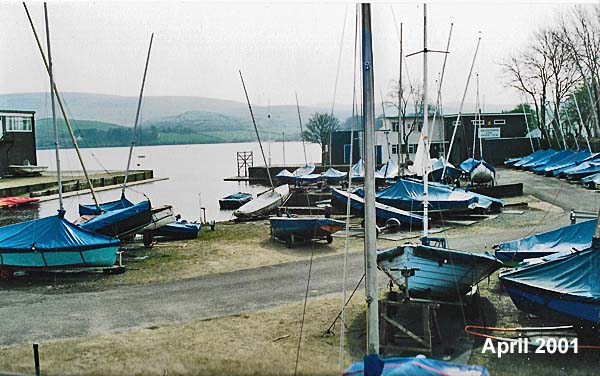
The image at the top of the page of the rower on a misty Hollingworth Lake is shown with the permission of Steve Pratt a professional photographer from the Rochdale area and the proprietor of Lambourne Images The image of the sailing boats on Hollingworth Lake is shown with the permission of Richard Whitworth on behalf of the Hollingworth Lake Sailing Club. |
Close Window
